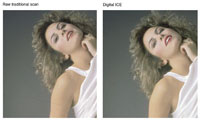Nikon Super CoolScan 2000
Nikon has been at the forefront
of 35mm film scanning from the beginning, and has enjoyed a top position
in the field most recently with the CoolScan LS-1000. Just a short time
ago Nikon announced a new CoolScan that would be better and easier to
use, but the one feature which caught everyone's attention was
its ability to recognize and cleanup film flaws like dirt and scratches.
This feature, Digital ICE, is a development of a company in Austin,
Texas called Applied Science Fiction, and involves hardware and software
functions new to scanning. More about Digital ICE later, while I describe
the rest of the features which distinguish the Nikon CoolScan 2000. |
|||
Digital ICE. As
any experienced 35mm camera user has surely discovered, the format's
greatest weakness is that its small image frame size collects dust readily
and is easily damaged by handling. Even freshly developed film is hard
to keep clean to avoid spotting enlarged prints made from it, much less
a frame from one's files that has been stored and handled and reprinted
a few times. In other words, the spotting and retouching 35mm has traditionally
demanded costs individual photographer's considerable time, as well
as photo labs, and other reproduction services adding up to a great deal
of extra money eventually paid for in the cost of services to you and
I. |
|||
Conclusion And Recommendation.
Although my description of and my experience working with LS-2000 has
involved more critical comments than usual from me, it is because Nikon
sets high expectations. However, this report is surely not the last word.
During the short time I had an evaluation unit Nikon released a new upgraded
4.1 version of the software with the announcement that they considered
the product a work in progress, which would continue to reflect refinements
and improvements. Considering its under $2000 price, high-resolution,
36-bit, 3.6 dynamic range specifications plus the exclusive for now Digital
ICE and multipass scanning, Nikon continues to offer the best in 35mm
scanning. Technical Specifications Scanner Type: 35mm
and APS film using a fixed target single pass scan |
- Log in or register to post comments




































